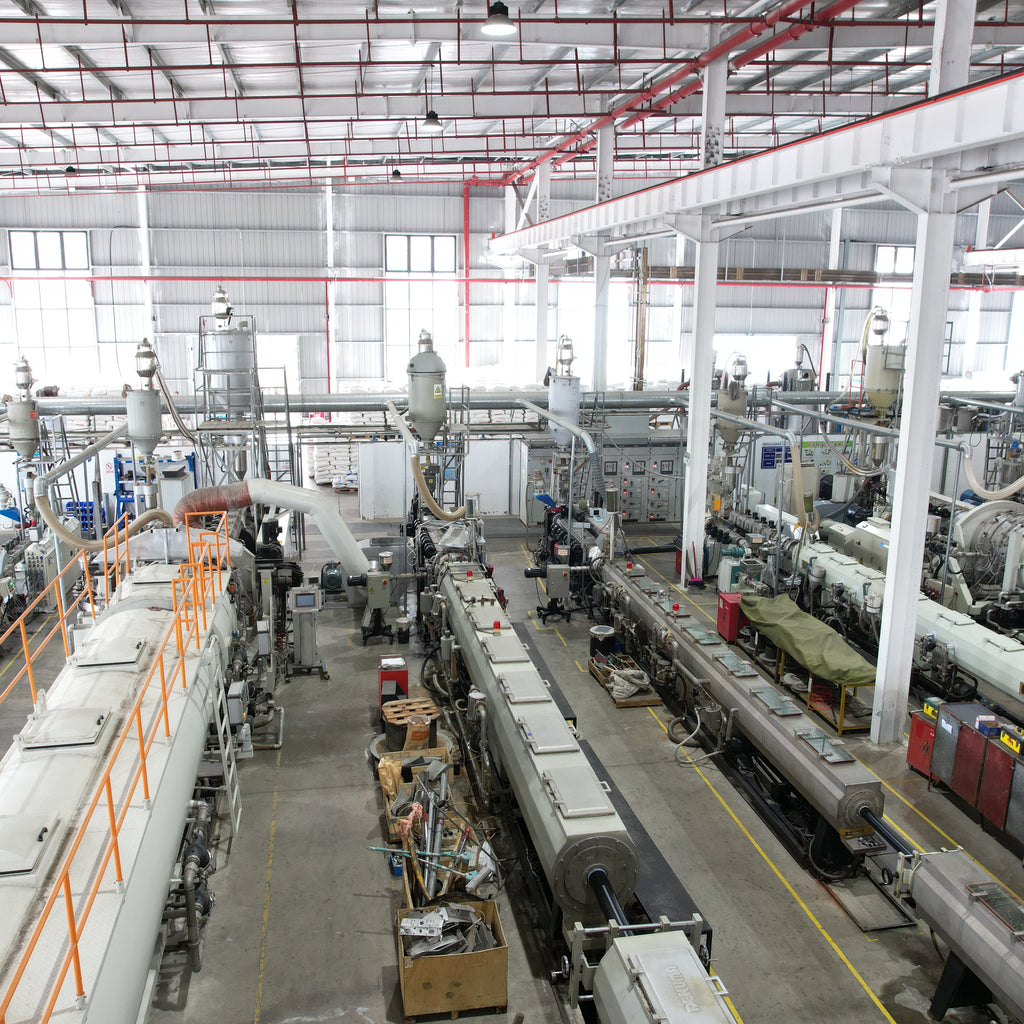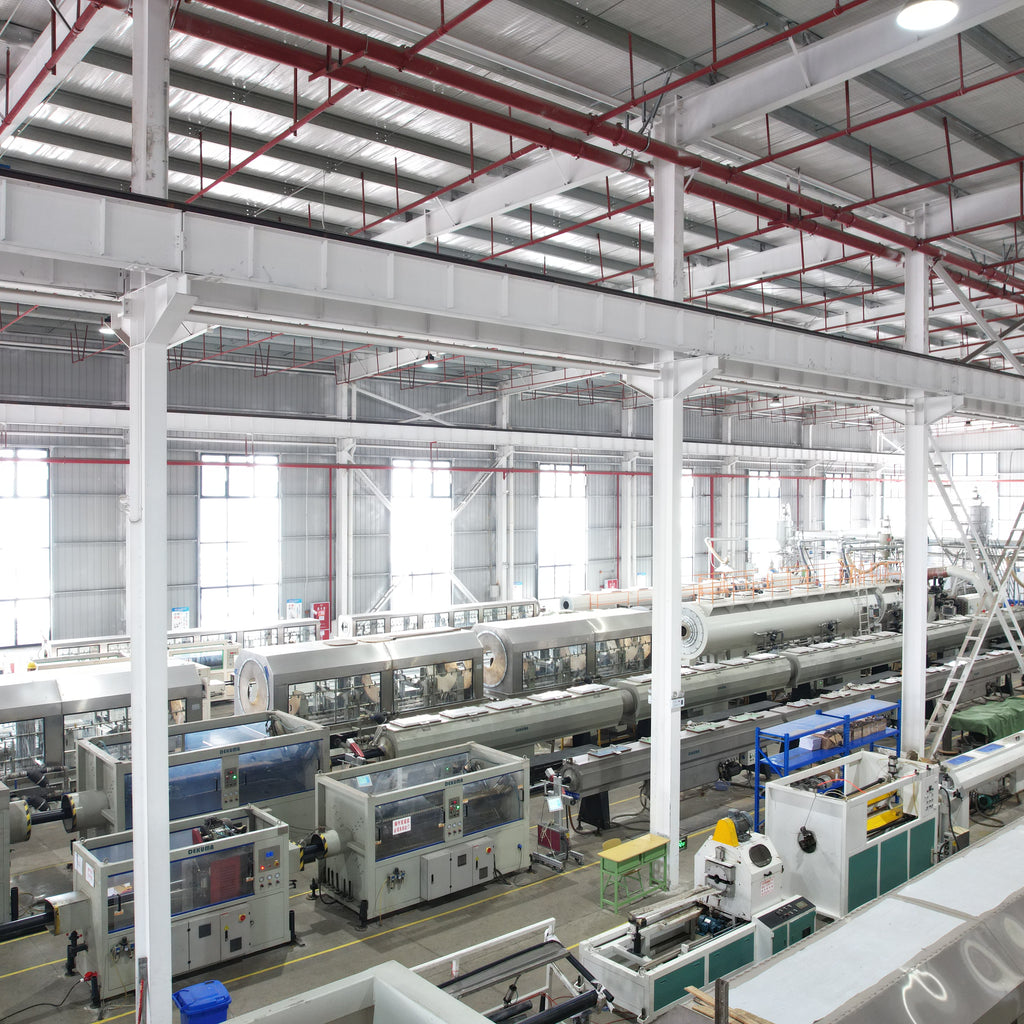Ultra-High Molecular Weight Polyethylene (UHMWPE) Pipes: Material Science, Technical Advantages, and Industrial Applications
Ultra-High Molecular Weight Polyethylene (UHMWPE) Pipes: Material Science, Technical Advantages, and Industrial Applications
1. Introduction
Ultra-High Molecular Weight Polyethylene (UHMWPE) pipes—characterized by a molecular weight exceeding 1.5 million g/mol—represent a transformative advancement in fluid and solid conveying systems. Distinguished by their entangled linear polymer chains and near-zero melt flow index, these pipes surmount the limitations of traditional steel, HDPE, and PVC alternatives, particularly in abrasive, corrosive, and extreme-temperature environments. As a globally recognized high-performance material compliant with standards including ASTM D3306 and GB/T 32471, UHMWPE pipes are redefining reliability across industries from mining to food processing. This article integrates material science fundamentals, latest engineering data, and real-world case studies to comprehensively analyze their technical merits, installation innovations, and application expansion.
2. Material Fundamentals & Core Performance Advantages
2.1 Unrivaled Abrasion Resistance
The dense molecular matrix of UHMWPE delivers industry-leading wear resistance, outperforming conventional materials by significant margins: it is 7–10 times more abrasion-resistant than steel, 27 times that of brass, and 5–7 times superior to standard polyethylene. In coal slurry conveying tests, UHMWPE pipes retained 90% of their original inner diameter after 10,000 hours of operation, while steel pipes exhibited 50% wear under identical conditions. This durability stems from the material’s ability to disperse abrasive forces across long polymer chains, eliminating surface erosion and extending service life to 50 years—2–3 times longer than HDPE and 4 times that of steel.
2.2 Extreme Impact & Low-Temperature Toughness
UHMWPE pipes boast the highest impact strength among engineering plastics, with a notched Izod impact strength exceeding 110 kJ/m²—10 times that of nylon 66 and 20 times greater than PVC. Uniquely, their toughness enhances in sub-zero conditions: at -196°C (liquid nitrogen temperature), they maintain full impact resistance, while steel and HDPE become brittle and prone to fracture. In arctic oilfield applications, UHMWPE pipes have operated continuously at -40°C without structural failure, achieving a low-temperature impact strength of 150 kJ/m².
2.3 Chemical Inertness & Corrosion Resistance
The saturated molecular structure of UHMWPE renders it inert to nearly all common corrosive media, including 80% hydrochloric acid, 75% sulfuric acid, 20% nitric acid, and alkali solutions across pH 1–14. Unlike steel, which requires costly anti-corrosion coatings, UHMWPE pipes eliminate coating maintenance and failure risks. In chemical fertilizer plants, they prevent chloride-induced pitting and fertilizer crystallization buildup that plagues stainless steel, reducing downtime by 90%. Their resistance to organic solvents also makes them ideal for petrochemical applications, where they outperform PTFE at 56% lower weight and 40% lower cost.
2.4 Low-Friction & Anti-Scaling Efficiency
With a friction coefficient of 0.07–0.11—comparable to ice-on-ice contact—UHMWPE pipes minimize flow resistance and energy consumption. This self-lubricating property enables 20% higher conveying efficiency than steel pipes and eliminates scaling, even in high-mineral-content media. In power plant fly ash disposal systems, their non-polar inner surface prevents ash buildup, maintaining consistent flow rates over decades and reducing pump energy use by 15%.
2.5 Lightweight Flexibility & Durability
At a density of 0.93–0.945 g/cm³, UHMWPE pipes are 1/8 the weight of steel and 50% lighter than HDPE, slashing transportation and installation labor costs by 40%. Their flexibility (bending radius = 20–25× pipe diameter) allows navigation around underground obstacles without additional fittings, while resistance to ground settlement damage makes them superior in seismic zones. Incorporating 2–2.5% carbon black, they resist UV degradation and maintain 70% of mechanical properties after 50 years of outdoor use.
3. Advanced Manufacturing & Installation Technologies
3.1 Specialized Extrusion Processes
UHMWPE’s ultra-high melt viscosity (up to 10⁹ Pa·s) and zero melt flow index require specialized manufacturing equipment. Modern production relies on two primary technologies:
- Plunger Extrusion: Reciprocating plungers compress, preheat, and sinter UHMWPE powder, creating dense pipes with uniform wall thickness (tolerance ±0.5 mm).
- Modified Screw Extrusion: Customized screws with enhanced mixing zones prevent "料塞" (material blockage) and ensure consistent melt flow, enabling continuous production of pipes up to 2000 mm in diameter.
These processes produce pipes with pressure ratings from 0.4 MPa to 2.0 MPa, meeting 静液压强度 requirements (e.g., 12.4 MPa at 20°C for 100 hours without leakage).
3.2 Reliable Connection Methods
UHMWPE pipes utilize connection technologies optimized for their material properties, ensuring leak-proof performance:
- Electrofusion Joining: Embedded heating elements melt pipe ends and fittings, creating a molecular bond with tensile strength exceeding the pipe itself. Critical steps include surface oxidation removal, precise alignment, and adherence to temperature/pressure parameters (typically 200–230°C). This method is preferred for gas and high-pressure liquid systems.
- Butt Fusion: Suitable for diameters ≥63 mm, this process heats pipe ends to 200–220°C, then presses them together to form a seamless joint. Daily "弯带测试" (bend strip testing) validates joint integrity onsite.
- Mechanical Connections: Flange and compression fittings offer versatility for small-diameter pipes, with silicone-lubricated ring seals ensuring watertightness in drainage applications.
3.3 Installation Best Practices
Compliant with standards like GB 50268, UHMWPE pipe installation leverages its lightweight flexibility:
- Trenchless Techniques: Directional drilling and 顶管 (pipe jacking) minimize surface disruption in urban areas, with pipes navigating curves without joint failure.
- Backfilling: Granular material (0–5 mm) prevents pipe deformation, while the material’s flexibility absorbs ground shifts.
- Inspection: Post-installation pressure testing (1.5× working pressure for 24 hours) and ultrasonic joint scanning ensure system integrity.
4. Key Application Domains & Case Studies
4.1 Mining & Mineral Processing
UHMWPE pipes dominate abrasive slurry transport:
- 山西某焦化厂: Replaced steel pipes in tailings conveyors, extending service life from 18 months to 4 years and cutting annual maintenance costs by $80,000.
- Iron Ore Mines: Transported ore slurries with 40% solids content, reducing pump energy use by 18% vs. rubber-lined steel pipes.
4.2 Chemical & Petrochemical Industry
Corrosion resistance drives adoption in harsh chemical environments:
- Fertilizer Plants: Conveyed 30% H₂SO₄ without corrosion, eliminating monthly steel pipe replacements and reducing downtime by 95%.
- Oil & Gas: Handled drilling mud containing hydrocarbons and salts, with anti-scaling properties improving flow efficiency by 25% vs. HDPE.
4.3 Water & Wastewater Treatment
Sanitary and corrosion-resistant properties suit municipal and industrial systems:
- Sludge Transport: Non-stick surface prevented biological fouling, reducing cleaning frequency from monthly to annually.
- Coastal Desalination: Withstood saltwater corrosion, outperforming stainless steel at 40% lower cost and achieving a 50-year service life.
4.4 Food & Pharmaceutical Processing
FDA 21 CFR § 177.1520 and EU 10/2011 compliant grades (e.g., TIVAR™ VMX) enable contact with food and pharmaceuticals:
- Dairy Processing: Conveyed milk and cleaning agents (CIP solutions) without chemical leaching, with smooth surfaces reducing bacterial growth.
- Pharmaceutical Manufacturing: Transferred active pharmaceutical ingredients (APIs) in ultra-clean systems, meeting ISO 14644-1 Class 8 standards.
5. Performance Comparison & Economic Value
5.1 Cross-Material Performance Metrics
|
Property
|
UHMWPE Pipe
|
Steel Pipe
|
HDPE Pipe
|
PVC Pipe
|
|
Density (g/cm³)
|
0.93–0.945
|
7.8
|
0.95
|
1.4
|
|
Abrasion Resistance (x steel)
|
7–10
|
1.0
|
1.0
|
0.5
|
|
Impact Strength (kJ/m²)
|
>110
|
27
|
<10
|
<10
|
|
Service Temp Range (°C)
|
-196 to 80
|
-20 to 425
|
-60 to 75
|
0 to 60
|
|
Friction Coefficient
|
0.07–0.11
|
>0.85
|
0.4
|
0.4
|
|
Service Life (Years)
|
50
|
15–20
|
30
|
25
|
|
Source:
|
|
|
|
|
5.2 Total Cost of Ownership (TCO) Analysis
While UHMWPE pipes have 1.5× higher initial cost than steel, their 50-year TCO is 6× lower:
- Installation: 50% less labor and equipment (no heavy lifting or coating).
- Energy: 20% lower pumping costs due to low friction.
- Maintenance: \(50–\)80/year vs. \(200–\)300/year for steel (no corrosion repairs).
- Replacement: Zero costs over 50 years vs. 2–3 steel pipe replacements.
6. Conclusion & Future Trends
UHMWPE pipes embody the convergence of material science and engineering practicality, offering unmatched durability, efficiency, and cost-effectiveness across extreme environments. Their ability to reduce energy consumption, maintenance downtime, and environmental impact aligns with global sustainability goals. Emerging advancements—including high-temperature grades (up to 135°C) and recycled UHMWPE formulations—will expand applications into renewable energy (biomass transport) and aerospace (cryogenic fluid systems).
For engineers specifying piping systems, UHMWPE’s technical advantages translate directly to operational resilience. To explore customized solutions—such as large-diameter pipes for port infrastructure or food-grade systems for beverage production—share your project’s pressure, temperature, and media requirements for tailored recommendations.
Sample Block Quote
Nam tempus turpis at metus scelerisque placerat nulla deumantos sollicitudin delos felis. Pellentesque diam dolor an elementum et lobortis at mollis ut risus. Curabitur semper sagittis mino de condimentum.
Sample Paragraph Text
Lorem ipsum dolor sit amet, consectetur adipiscing elit. Morbi ut blandit risus. Donec mollis nec tellus et rutrum. Orci varius natoque de penatibus et magnis dis parturient montes, nascetur ridiculus mus. Ut consequat quam a purus faucibus scelerisque. Mauris ac dui ante. Pellentesque congue porttitor tempus. Donec sodales dapibus urna sed dictum.



